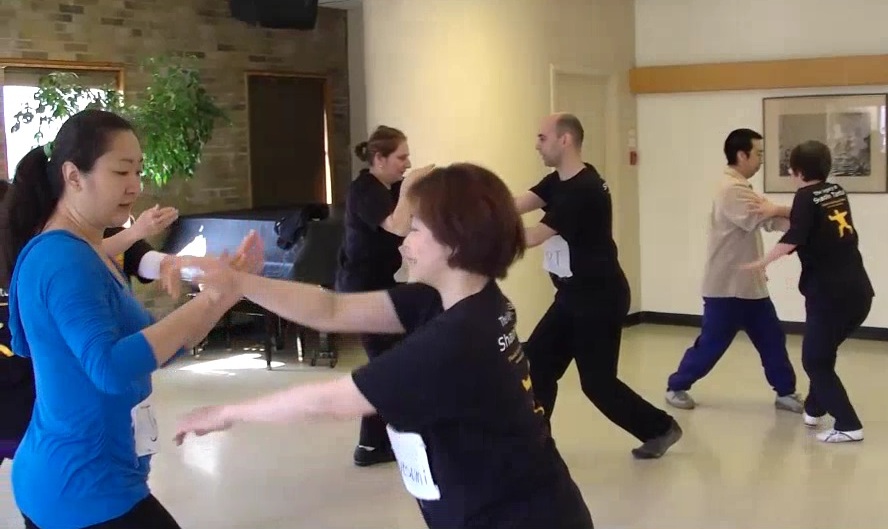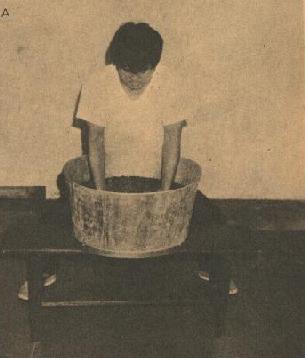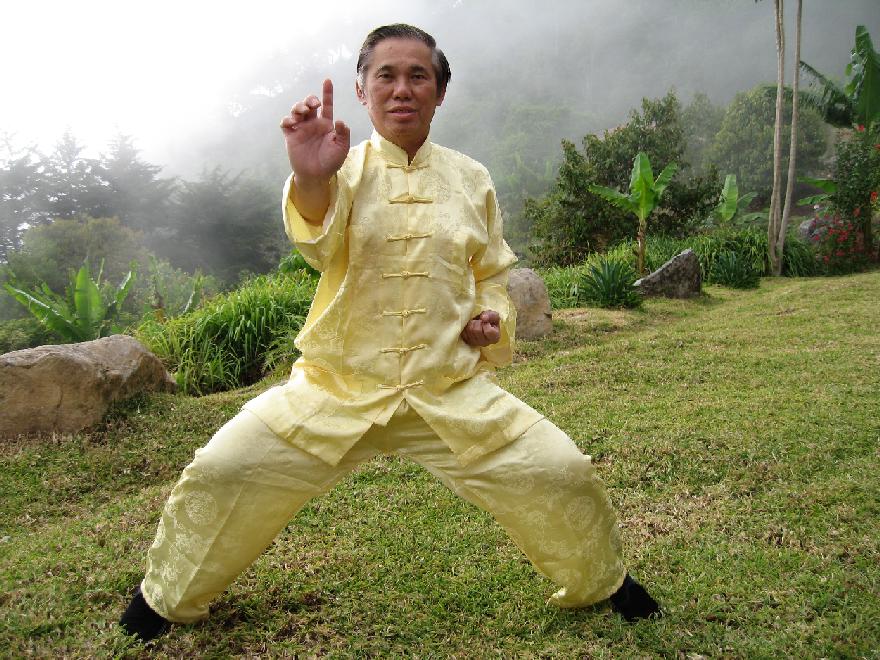WHY SHOULD YOUR SCHOOL SUBSTITUTE EXTERNAL TRAINING WITH INTERNAL CULTIVATION?
Why should you bleed, sweat, toil and wail — literally or figuratively — in any art, be it wushu, Chan cultivation, dancing or folk singing, when you practice it as a hobby? -- Grandmaster Wong Kiew Kit
 Every practice in our school, including combat application, is a training of energy and mind, i.e. internal cultivation
Every practice in our school, including combat application, is a training of energy and mind, i.e. internal cultivation
Question
From what I have heard, a large part of strengthening and improving is by extensive cultivation of chi in the various internal exercises you teach. This is supposed to substitute a fair amount of the extreme external training such as lifting weights and running or other very strenuous exercises that builds and strengthens ones body. I have never heard from any other system that one should substitute demanding external training with harnessing chi. Chi of course is an integral part of training; external kungfu training and chi go hand in hand. But internal exercise obviously doesn't, or shouldn't, substitute gruelling external training. Lipster, England
Answer
It is true that we practice little or no extreme external training or very strenuous exercise like lifting weights and running, but this does not mean we do not pay attention to external training or to build and strengthen our body.In our school, Shaolin Wahnam, we believe in and actually practice both external and internal training, both hard and soft approaches, and we are guided by the triple cultivation of body, energy and mind.
Our training or cultivation is integrated, not isolated one by one. In other words, we do not first do external training then internal training, first soft approach then hard approach, first the body, then energy and then mind. All these aspects are involved together whenever we train, though for some particular purposes we may emphasize one aspect more than another.
For example, when we perform a kungfu set, we do not merely perform the forms. Doing so will be only external training. We also pay much attention on how to regulate our breathing, which is energy training, and on how to focus our mind, which is mind training. Depending on the specific objectives of the training session in question, we may place more emphasis on one aspect over the others, or we may place equal emphasis on all.
For example, if the specific objective is to perfect a defence module against a particular attack, we would pay more attention to form, and regulate our breathing and focus our mind appropriately to achieve the best effect.
If the objective is to explode force to bounce off an opponent's attack, our emphasis would be on energy management, such as how to accumulate our chi at the dan tian and direct it out to our defence explosively, and we use the best physical form and state of mind for this purpose.
If the objective is to train correct judgment, we would pay more attention to mind, like entering into an appropriate mental and bodily state where we are totally relaxed and sharply focused, while maintaining our correct form and breathing.
Such a division into emphasizing different aspects in different training sessions is for the convenience of training. In application, in sparring or in our daily life, we respond to the situation correctly and spontaneously, without worrying about what forms, breathing mode or mental state to use. For example, when an opponent grabs our arm or when we alight from a train, we spontaneously and elegantly release the grip or leave the train, without worrying about form, energy or mind.
Hence, it is incorrect to say that in our school a large part of strengthening and improving our body is by extensive cultivation of chi. I often remind my students that chi kung is not just chi cultivation, but equally jin cultivation and shen cultivation, i.e. chi kung is not just cultivation of energy, but equally cultivation of the physical body and cultivation of mind. If a person has a lot of energy, or is mentally sharp, but is slow and clumsy in his movements, then he has not done well.
Our belief of equal importance of body, energy and mind, though we may at times place emphasis on one aspect for particular reasons is a main philosophical difference, and consequently a main difference in methodology, between our school and many other schools. For example, many martial art schools place much emphasis on physical training like weight training and running, but we don't. Some spiritual disciplines only train the mind to the extent of neglecting their body, but we train both our mind and body.
Your comment that “chi is an integral part of training; external kungfu training and chi go hand in hand” is only a philosophical ideal. In practice it is usually not true. Most external kungfu and external martial art schools have no idea of chi. For example, almost all external schools, and even many internal schools, perform their sets or katas without paying attention to breath control. Some martial artists do not even believe chi exists.
Ours is not the only school that places emphasis on all the three aspects of body, energy and mind. In fact, all traditional kungfu schools do so, or at least did so and at least in theory, though the emphasis may not be of equal proportions. The concept of jin, qi and shen, or form, energy and mind, is fundamental in kungfu and chi kung, but due to various reasons many schools today have lost the aspects of energy and mind.
Shaolin Kungfu, Taijiquan, Baguazhang and Hsing Yi Kungfu are particularly well known for their emphasis on energy and mind besides form. In fact, in Taijiquan form is sometimes regarded as secondary to energy and mind, as a means to train internal force and attain spiritual fulfillment. The term “Hsing Yi” literally means “form and intent”, signifying equal importance on both the external and the internal.
Due to various reasons, many kungfu schools today place emphasis only on form. A notable example is the many derivatives from Shaolin Kungfu, such as Hoong Ka Kungfu, Lau Ka Kungfu and Choy-Li-Fatt Kungfu. This was because their first patriarchs and early masters were revolutionaries, who devoted their time to training fighting techniques for overthrowing the Manchurian government, rather than to training energy and mind for spiritual fulfillment.
Another notable example is modernized wushu. This was because the Communist government which started wushu did not believe in spiritual development, and like many materialistic Westerners, did not believe in chi. Wushu is also devoid of fighting aspects because originally it was invented for sport. But wushu exponents, due to their strong connection with Chinese culture, should have heard of chi, but most of them do not have any experience of it.

Question
I think you would agree that the one concept mutually accepted by any martial art system since the beginning of time is simple -- hard work. Blood, sweat, toil and tears. Period point blank. This is the only way you will become stronger. There is no short cut. I have never come across any other system that replaces so much of the extremely tough workouts with chi cultivation. So I find it hard to comprehend why your system of teaching does not encourage more plain old hard work.
Answer
Hard work is a basic requirement for any success, be it in kungfu, spiritual cultivation or business. But hard word is not necessary blood, sweat, toil and tears. In fact it shouldn't be. Why should you bleed, sweat, toil and wail — literally or figuratively — in any art, be it wushu, Chan cultivation, dancing or folk singing, when you practice it as a hobby?My chi kung, Shaolin Kungfu and Taijiquan courses involve hard work. My Intensive Shaolin Kungfu Course is very, very hard work. I often say jokingly that by comparison my chi kung course is for lazy people, and my Taijiquan course is for children to play.
But actually those who attend my chi kung and Taijiquan courses are smart; they do not have to undergo the very hard work in Shaolin Kungfu, yet get more than enough benefits for their needs. Then, why do my students attend my Shaolin Kungfu course? They want the best and are willing to work very hard to get it.
But the hard work we do is very different from what you imagine. You toil and sweat for an hour, and return home tired and in pain. You have to rest, or cool down, for another hour before you can do any useful work, or even to enjoy yourself. You work hard, as Vince correctly pointed out elsewhere, like a water-buffalo.
Students at my Yi Jin Jing class flick their fingers three times, the whole practice taking only about 5 minutes, and they can develop sufficient internal force to enable them to work or enjoy themselves the whole day! Students at my Intensive Shaolin Kungfu Course spar or train internal force, which is very demanding, for eight hours, then return home, have a shower and immediately go out with their dates.
If you are used to water-buffalo training and think that it is the only way to make you strong, even if we skin your buffalo hide you would not believe what I have said is true. This is one main reason why some people, but not you, slander me behind my back, saying that I am a fraud. They, and you, had a golden opportunity to experience these effects themselves at my chi kung courses held recently, but they chose to argue verbosely instead of directly experience the effects or otherwise to confirm or debunk my claims.
I wish to add that these results in my courses, which may seem impossible to many people, are not the exception; they are the norm. That means anyone who attends my courses is expected to have these results.
The reason why you have “never come across any other system that replaces so much of the extremely tough workouts with chi cultivation”, is simple. You are extremely limited in your views and exposure.
As I have said earlier, mine is not the only system to use chi cultivation to replace the extremely tough workouts you have in mind. There are many others. Genuine Taijiquan and Baguazhang masters are very powerful, more powerful than weight-lifters and body-builders, but they never use water-buffalo workouts. .

Reproduced from Questions 5 and 6 in Selection of Questions and Answers — January 2003 Part 2
Please e-mail your questions to Grandmaster Wong Kiew Kit stating your name, country and this webpage for reference. E mails without these particulars may not be answered.
